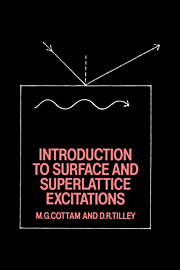Book contents
- Frontmatter
- Contents
- Preface
- 1 Introduction
- 2 Surface waves on elastic media and liquids
- 3 Surface magnons
- 4 Surface magnetostatic modes
- 5 Electronic surface states and dielectric functions
- 6 Surface polaritons
- 7 Layered structures and superlattices
- 8 Concluding remarks
- Appendix Green functions and linear response theory
- References
- Index
5 - Electronic surface states and dielectric functions
Published online by Cambridge University Press: 28 October 2009
- Frontmatter
- Contents
- Preface
- 1 Introduction
- 2 Surface waves on elastic media and liquids
- 3 Surface magnons
- 4 Surface magnetostatic modes
- 5 Electronic surface states and dielectric functions
- 6 Surface polaritons
- 7 Layered structures and superlattices
- 8 Concluding remarks
- Appendix Green functions and linear response theory
- References
- Index
Summary
In earlier chapters of this book we have seen how in some circumstances a surface mode can arise at a frequency within a forbidden gap for the corresponding bulk mode. For example, the calculation of §2.1.2 for a semi-infinite diatomic lattice shows such a mode appearing in the frequency gap between the acoustic and optic branches. The first calculation of this kind for electronic structure was carried out by Tamm (1932), who considered a model of a simple 1D system comprising a semi-infinite lattice of square wells. For about twenty years after his calculation was published, various other calculations for model systems were performed. Attention then shifted to the question of performing realistic calculations for actual surfaces, the theoretical methods being developed from those used for calculation of bulk electronic band structure. A full treatment of this later work would involve an extensive account of band-structure theory, and is beyond the scope of this book. Instead, we restrict attention in §5.1 to a brief account of model calculations together with a description of some relevant experimental results. The reader interested in more recent work on electronic surface states may refer to Ehrenreich et al. (1980), and in particular the article by Kelly (1980) contains a list of earlier reviews.
- Type
- Chapter
- Information
- Introduction to Surface and Superlattice Excitations , pp. 157 - 182Publisher: Cambridge University PressPrint publication year: 1989



